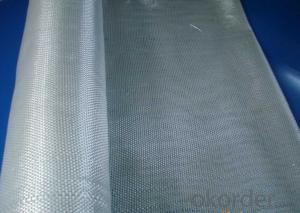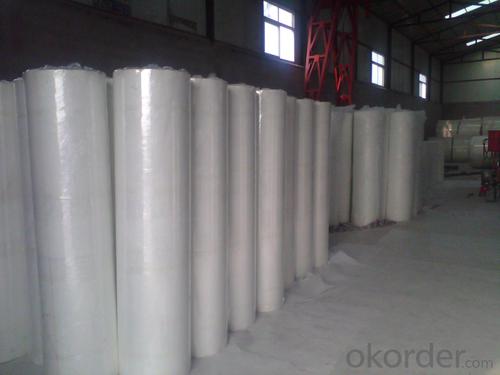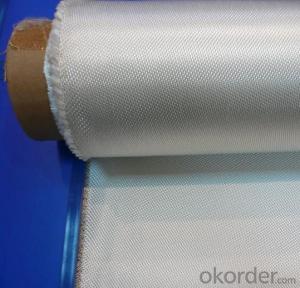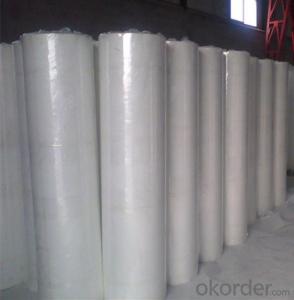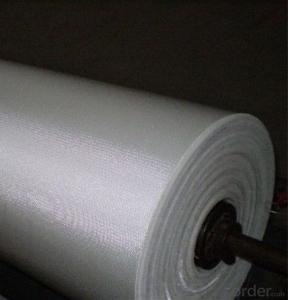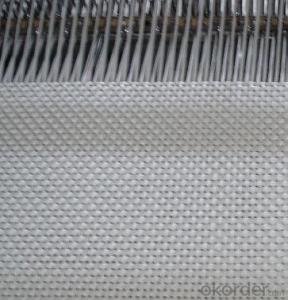Fiberglass Yarn Reinforced Fiberglass Fabric for Pipeline Ductile Conjunction
- Loading Port:
- Shanghai
- Payment Terms:
- TT OR LC
- Min Order Qty:
- 500 m²
- Supply Capability:
- 50000 m²/month
OKorder Service Pledge
OKorder Financial Service
You Might Also Like
Fiberglass Fabric for Pipeline Ductile Conjunction
Fiberglass Fabric Introduction:
Fiberglass fabric is weaved by high quality fiberglass,as a kind of engineering material,which is
many excellent characteristics:
flame-resisting,corrosion resistant,high strength,heat resistance.stable structure,good chemical resistance,durability.
Fiberglass Fabric Features:
Warp and weft yarns are parallel arrangement as flat situation, with uniform tension;
Fiber is aligned with large consistency, stable and easy operation;
Good moldability, fast and complete wet out in resins, resulting in high productivity;
Good transparency and high strength of composite products.
Fiberglass Fabric Specification:
mark | Fiber consistency(ends/ cm) |
Area weight (g/ m2) |
Thick-ness (mm) |
Width (cm) |
Length (mm) | Breaking strength(N)≥ |
weave | |||
Warp direction | Weft direction | Warp direction | Weft direction | |||||||
EW200 | 16 | 12 | 200±20 | 0.2 | 90-130 | 300-1200 | 980 | 980 | ||
EW210 | 16 | 12 | 200±20 | 0.21 | 90-130 | 300-1200 | 1080 | 1080 | Twill weave | |
Plain weave | ||||||||||
EWR360 | 3.2 | 1.8 | 354±18 | 0.35 | 50-300 | 100 | 2000 | 2000 | ||
EW280 | 16 | 10 | 280±28 | 0.26 | 90-130 | 300-1200 | 1800 | 1800 | ||
EW300 | 14 | 10 | 320±32 | 0.3 | 90-130 | 300-1200 | 1500 | 1500 | ||
EW430 | 20 | 12 | 420±42 | 0.43 | 90-130 | 300-1200 | 2000 | 2000 | Broken twill | |
EWR136 | 10 | 10 | 136±13 | 0.136 | 100 | 200 | 850 | 850 |
Plain weave | |
EWR200 | 8 | 7 | 200±20 | 0.21 | 100 | 200 | 1200 | 1200 | ||
EWR400 | 3.6 | 3.2 | 400±30 | 0.4 | 100 | 50-100 | 2500 | 2500 | ||
EWR600 | 2.6 | 2.5 | 600±50 | 0.6 | 100 | 40KG | 4000 | 4000 | ||
EWR580 | 2.5 | 2.3 | 576±29 | 0.58 | 100 | 40KG | 3850 | 3850 | ||
EWR800 | 1.8 | 1.8 | 800±60 | 0.8 | 100 | 40KG | 4600 | 4600 | ||
Product Show


Fiberglass Fabric Usage:
E-glass woven roving is a schistose double faces reinforcement fabric that is weaved into from roving in directly.
E-glass fiber fabric (thin fabrics with thickness from 0.025 to 0.09mm) is suitable for electrical isolation mica product, wax cloth as the reinforcement materials.
E-glass woven roving applys to all kinds of polyester reinforcement system, (such as unsaturated polyester resin, vinylite,epoxy resin and phenolic resin.
E-glass woven roving is a high performance reinforcement material. It is widely used in hand lay-up and machinery processing products, (such as vessel, container, airplane and vehicle component, furniture, athletic facilities and other industry.
FAQ
1.Package of Fiberglass Fabric?
Fiberglass fabric is wound on a paper tube with inner diameters of 50. 8, 76 or 152mm. Each roll is wrapped in a plastic bag, then to be packed in a carton box. The rolls are to be horizontally placed.
Width (cm): 90, 100, 127
Length (m): 100, 200, 300, 400
2.Storage of Fiberglass Fabric?
Store rolls in a cool, dry location
Protect rolls from weather and other damage.
3.If sample available if needed?
We aim to offer our customer best Products&Service,samples are allowed if necessary.
- Q: Is fiberglass yarn resistant to fungus?
- Yes, fiberglass yarn is generally resistant to fungus.
- Q: How does fiberglass yarn perform in UV resistance?
- Fiberglass yarn generally has good UV resistance properties. It is known to withstand prolonged exposure to sunlight without significant degradation or loss of strength. The unique composition of fiberglass, with its inorganic nature and resistance to chemical reactions, contributes to its ability to resist UV radiation effectively. As a result, fiberglass yarn is often used in outdoor applications where protection against UV rays is crucial, such as in boat building, roofing materials, or automotive components.
- Q: Can fiberglass yarn be used in the production of carpeting?
- Yes, fiberglass yarn can be used in the production of carpeting.
- Q: How does the resistance to fatigue of fiberglass yarn compare to other materials?
- Fiberglass yarn is widely recognized for its exceptional resistance to fatigue, surpassing many other materials in this aspect. Its high strength and durability enable it to endure repeated stress and strain without experiencing significant performance deterioration. In comparison to materials like cotton or wool, fiberglass yarn exhibits far greater resistance to fatigue. Cotton and wool fibers tend to weaken and deteriorate over time, particularly when subjected to repeated bending or stretching. In contrast, fiberglass yarn maintains its structural integrity and strength even after extensive use or exposure to harsh conditions. Similarly, when compared to synthetic materials such as nylon or polyester, fiberglass yarn demonstrates superior fatigue resistance. Although nylon and polyester are renowned for their strength and durability, they are still susceptible to fatigue and eventual wear and tear. Conversely, fiberglass yarn exhibits exceptional resistance to fatigue, allowing it to endure heavy usage and sustain optimal performance over an extended lifespan. Furthermore, fiberglass yarn's resistance to fatigue often outperforms that of metals like steel or aluminum. While metals possess high strength, they can still experience fatigue failure due to repeated loading or stress. As a non-metallic material, fiberglass yarn avoids the fatigue-related issues associated with metals, rendering it a more dependable choice in numerous applications. All in all, the fatigue resistance of fiberglass yarn is truly remarkable. Its capacity to withstand repetitive stress and strain without significant performance deterioration makes it highly suitable for demanding applications where durability and longevity are paramount.
- Q: How does fiberglass yarn perform in terms of durability?
- Known for its exceptional durability, fiberglass yarn is highly resistant to wear and tear, making it an excellent choice for applications that require long-lasting performance. The inherent strength and stability of fiberglass yarn allow it to withstand various environmental conditions, including extreme temperatures, moisture, chemicals, and UV radiation. Moreover, fiberglass yarn exhibits excellent dimensional stability, meaning it retains its shape and size even under significant stress. This exceptional durability renders fiberglass yarn suitable for a wide range of industries, including construction, automotive, aerospace, and marine, where high-strength materials are essential. In summary, fiberglass yarn provides outstanding durability, making it a reliable option for applications that demand enduring performance and resistance to damage.
- Q: Is fiberglass yarn resistant to pests or insects?
- Yes, fiberglass yarn is highly resistant to pests and insects. The material is made from spun glass fibers, which do not provide a suitable environment for pests to thrive. Fiberglass yarn is not appealing to insects, as it does not contain any organic matter that they typically feed on. Additionally, the smooth and slippery surface of the fiberglass yarn makes it difficult for pests to crawl or burrow into. Therefore, fiberglass yarn is an excellent choice for applications where pest and insect resistance is desired, such as in the construction of screens, insulation, and textiles.
- Q: Is fiberglass yarn suitable for making window blinds?
- Yes, fiberglass yarn is suitable for making window blinds. Fiberglass yarn is known for its durability, strength, and resistance to moisture, heat, and UV rays. These properties make it an ideal material for window blinds as it can withstand the harsh conditions of sunlight exposure and maintain its shape and functionality over time. Additionally, fiberglass yarn is lightweight and easy to work with, making it suitable for creating various styles and designs of window blinds. It is also a fire-resistant material, which adds an extra level of safety to window blinds. Overall, fiberglass yarn is a reliable choice for making window blinds due to its durability, resistance to environmental factors, and ease of use.
- Q: Can fiberglass yarn be used in the production of curtains and blinds?
- Yes, fiberglass yarn can be used in the production of curtains and blinds. It is a versatile material that offers durability, strength, and resistance to heat and moisture, making it suitable for use in window coverings. Additionally, fiberglass yarn can be woven into various patterns and textures, offering a wide range of design possibilities for curtains and blinds.
- Q: What are the advantages of using fiberglass yarn in reinforced plastics?
- One of the advantages of using fiberglass yarn in reinforced plastics is its high strength-to-weight ratio. Fiberglass yarn is known for its exceptional tensile strength, making it an ideal material for reinforcing plastic composites. Additionally, fiberglass yarn offers excellent resistance to corrosion, chemicals, and UV radiation, enhancing the durability and longevity of the reinforced plastics. Moreover, fiberglass yarn can be easily woven into different patterns, providing flexibility in design and allowing for customized reinforcement.
- Q: Is fiberglass yarn suitable for use in automotive composites?
- Yes, fiberglass yarn is suitable for use in automotive composites. It is a commonly used material due to its high strength-to-weight ratio, excellent resistance to chemicals and temperature, and its ability to be easily molded into different shapes. Fiberglass composites provide structural support and enhance the overall performance and durability of automotive components.
Send your message to us
Fiberglass Yarn Reinforced Fiberglass Fabric for Pipeline Ductile Conjunction
- Loading Port:
- Shanghai
- Payment Terms:
- TT OR LC
- Min Order Qty:
- 500 m²
- Supply Capability:
- 50000 m²/month
OKorder Service Pledge
OKorder Financial Service
Similar products
Hot products
Hot Searches

